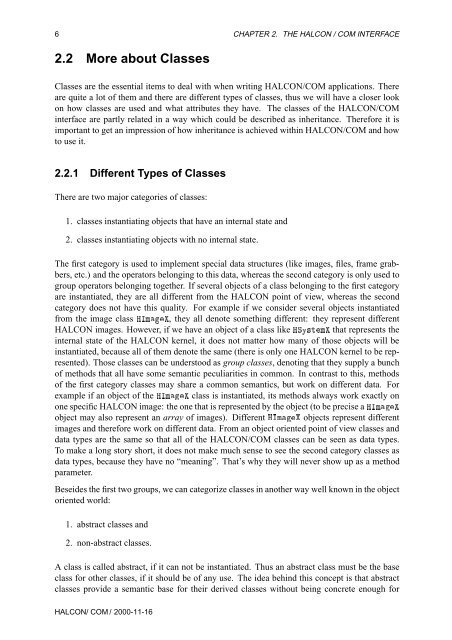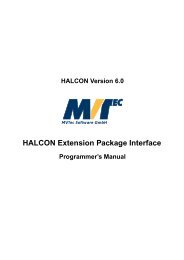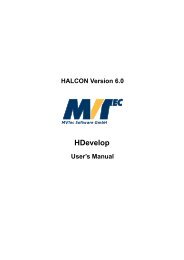HALCON/COM User's Manual
HALCON/COM User's Manual
HALCON/COM User's Manual
You also want an ePaper? Increase the reach of your titles
YUMPU automatically turns print PDFs into web optimized ePapers that Google loves.
6 CHAPTER 2. THE <strong>HALCON</strong> / <strong>COM</strong> INTERFACE<br />
2.2 More about Classes<br />
Classes are the essential items to deal with when writing <strong>HALCON</strong>/<strong>COM</strong> applications. There<br />
are quite a lot of them and there are different types of classes, thus we will have a closer look<br />
on how classes are used and what attributes they have. The classes of the <strong>HALCON</strong>/<strong>COM</strong><br />
interface are partly related in a way which could be described as inheritance. Therefore it is<br />
important to get an impression of how inheritance is achieved within <strong>HALCON</strong>/<strong>COM</strong> and how<br />
to use it.<br />
2.2.1 Different Types of Classes<br />
There are two major categories of classes:<br />
1. classes instantiating objects that have an internal state and<br />
2. classes instantiating objects with no internal state.<br />
The first category is used to implement special data structures (like images, files, frame grabbers,<br />
etc.) and the operators belonging to this data, whereas the second category is only used to<br />
group operators belonging together. If several objects of a class belonging to the first category<br />
are instantiated, they are all different from the <strong>HALCON</strong> point of view, whereas the second<br />
category does not have this quality. For example if we consider several objects instantiated<br />
from the image class ÀÁÑ, they all denote something different: they represent different<br />
<strong>HALCON</strong> images. However, if we have an object of a class like ÀËÝ×ØÑ that represents the<br />
internal state of the <strong>HALCON</strong> kernel, it does not matter how many of those objects will be<br />
instantiated, because all of them denote the same (there is only one <strong>HALCON</strong> kernel to be represented).<br />
Those classes can be understood as group classes, denoting that they supply a bunch<br />
of methods that all have some semantic peculiarities in common. In contrast to this, methods<br />
of the first category classes may share a common semantics, but work on different data. For<br />
example if an object of the ÀÁÑ class is instantiated, its methods always work exactly on<br />
one specific <strong>HALCON</strong> image: the one that is represented by the object (to be precise a ÀÁÑ<br />
object may also represent an array of images). Different ÀÁÑ objects represent different<br />
images and therefore work on different data. From an object oriented point of view classes and<br />
data types are the same so that all of the <strong>HALCON</strong>/<strong>COM</strong> classes can be seen as data types.<br />
To make a long story short, it does not make much sense to see the second category classes as<br />
data types, because they have no “meaning”. That’s why they will never show up as a method<br />
parameter.<br />
Beseides the first two groups, we can categorize classes in another way well known in the object<br />
oriented world:<br />
1. abstract classes and<br />
2. non-abstract classes.<br />
A class is called abstract, if it can not be instantiated. Thus an abstract class must be the base<br />
class for other classes, if it should be of any use. The idea behind this concept is that abstract<br />
classes provide a semantic base for their derived classes without being concrete enough for<br />
<strong>HALCON</strong>/ <strong>COM</strong> / 2000-11-16
















